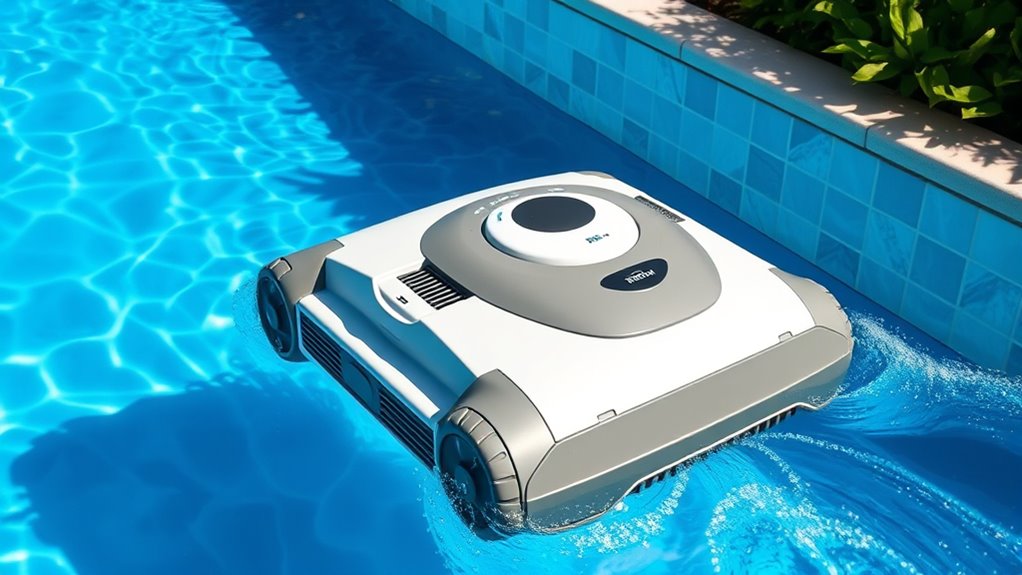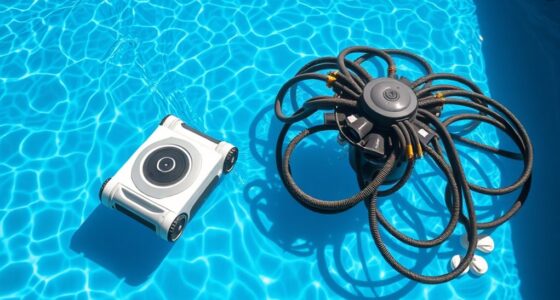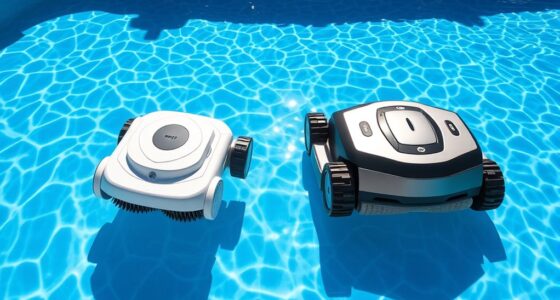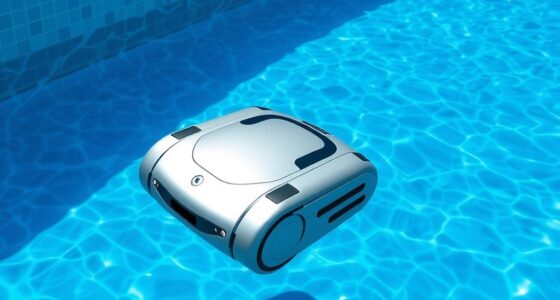The automatic pool cleaners industry is booming thanks to advances in robotic technology that make pool maintenance easier and more efficient. Modern cleaners are equipped with smart sensors, AI, and eco-friendly features, allowing them to navigate, scrub, and collect debris independently. These devices are becoming more affordable, reliable, and integrated with smart home systems. As innovation continues, you’ll discover how these evolving tools can transform your pool care routine and save you time.
Key Takeaways
- The industry has seen rapid growth driven by technological innovations like robotic systems, sensors, and AI for efficient pool cleaning.
- Modern automatic pool cleaners operate independently, offering features such as surface mapping, obstacle avoidance, and customizable modes.
- Market drivers include consumer demand for convenience, eco-friendly designs, smart home integration, and decreasing device costs.
- Industry trends focus on advanced sensors, energy efficiency, solar-powered options, and enhanced user-friendly features.
- The industry improves pool maintenance by reducing manual effort, enabling remote control, and promoting healthier, cleaner pools.
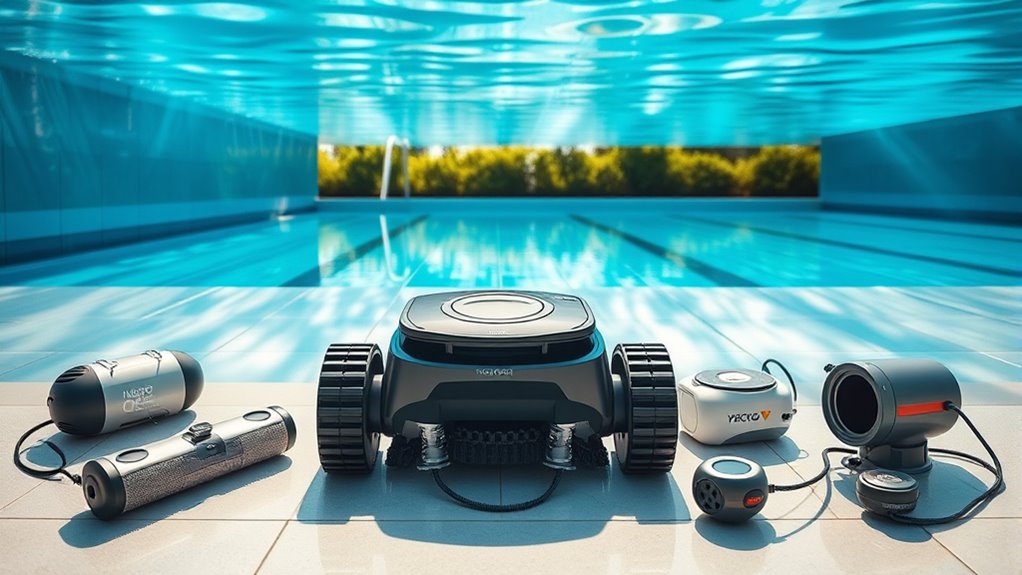
Have you ever wondered how automatic pool cleaners have transformed pool maintenance? It’s a good question, especially given how much these devices have evolved over recent years. The secret lies in advancements like robotic technology, which has revolutionized the way pools stay clean. These robotic cleaners are now smarter, more efficient, and more user-friendly than ever before. As a result, the market growth for automatic pool cleaners has been rapid, driven by increasing consumer demand for convenience and innovation. Today’s robotic pool cleaners use sophisticated sensors, programmable features, and powerful motors to navigate pools, scrub surfaces, and collect debris with minimal human intervention.
Robotic pool cleaners revolutionize maintenance with smart sensors, efficient navigation, and minimal effort, making pool care easier than ever.
The integration of robotic technology into pool cleaning has made a significant difference. Unlike traditional vacuum systems that require hoses, pumps, or manual labor, robotic cleaners operate independently. They are equipped with intelligent algorithms that allow them to map out pools, avoid obstacles, and clean every inch thoroughly. This automation reduces the time and effort pool owners need to spend maintaining their pools. Plus, robotic cleaners are designed to be energy-efficient, cutting down on electricity costs compared to older systems. This blend of smart technology and energy savings has made robotic pool cleaners an attractive choice for a wide range of consumers. Additionally, the development of advanced control systems has further enhanced user experience and operational efficiency.
The market growth of automatic pool cleaners has been fueled by several factors. First, consumers are seeking more convenient ways to maintain their pools. Manual cleaning is often tedious and time-consuming, so robotic options offer a compelling alternative. Second, technological advancements have made these devices more affordable and reliable, broadening their appeal. Manufacturers are investing heavily in R&D to improve battery life, navigation systems, and filtration capabilities, which further boosts market expansion. Additionally, the rise of smart home integration has paved the way for robotic pool cleaners to become part of broader automation ecosystems. You can now control and monitor your pool cleaner remotely via smartphone apps, adding extra convenience.
Furthermore, the industry is seeing a trend toward sustainable and eco-friendly designs, which appeal to environmentally conscious consumers and help reduce energy consumption. The development of advanced sensors and AI has further enhanced the efficiency and effectiveness of these devices. Moreover, innovations in customizable cleaning modes allow users to tailor cleaning routines to specific pool needs, increasing user satisfaction. As the industry continues to grow, you can expect even more innovative features to emerge. Enhanced sensors, AI-powered navigation, and eco-friendly designs are on the horizon. For example, some models now incorporate solar power options, reducing reliance on traditional electricity sources. The increasing availability of these advanced options means that more pool owners will be able to enjoy the benefits of automated cleaning without hassle. Overall, robotic technology has not only improved the efficiency of pool maintenance but has also driven significant market growth, making automatic pool cleaners a staple in modern pool care. For you, this means fewer worries, more free time, and a cleaner, healthier swimming environment.
Frequently Asked Questions
How Do Automatic Pool Cleaners Impact Energy Consumption?
Automatic pool cleaners can reduce your energy consumption by being more energy-efficient than traditional methods. They typically use less power, focusing on optimized cleaning patterns that minimize unnecessary operation, which boosts energy efficiency. By choosing models with low power consumption, you help cut down on energy use, saving you money and reducing your environmental impact. So, investing in an efficient cleaner directly impacts overall power consumption, making your pool maintenance more eco-friendly.
What Are the Latest Technological Innovations in Pool Cleaning?
Imagine your pool getting a spa day, thanks to cutting-edge tech. The latest innovations feature robot navigation that’s like a seasoned tour guide, expertly mapping every corner. Smart sensors act as the pool’s own senses, detecting dirt and debris for targeted cleaning. These advancements make automatic pool cleaners smarter, faster, and more efficient, turning pool maintenance into a seamless dance of technology that keeps your water crystal clear with minimal effort.
How Does Maintenance Differ Between Robot and Suction-Side Cleaners?
You’ll find maintenance procedures differ between robot and suction-side cleaners. Robots typically require regular brush and filter cleanings, with cleaning frequency depending on pool usage and debris. Suction-side cleaners need their hoses checked and filters cleaned often, especially in high debris areas. Robots often need less frequent maintenance, but both types benefit from consistent upkeep to ensure peak performance and longevity.
What Are the Environmental Impacts of Automatic Pool Cleaners?
You might wonder about the environmental impacts of automatic pool cleaners. These devices can reduce chemical runoff by minimizing the need for excessive chemicals, helping protect aquatic ecosystems. However, some models use energy that contributes to pollution. By choosing energy-efficient cleaners and properly maintaining them, you can lessen their environmental footprint, ensuring they support a healthier environment while keeping your pool clean.
How Do Seasonal Changes Affect Cleaner Performance?
You notice that seasonal changes impact your automatic pool cleaner’s performance. During colder months, you might need to do seasonal maintenance, like checking for ice or debris buildup, to guarantee efficient operation. In hot, dry climates, climate adaptation involves cleaning filters more often to prevent clogging. Regularly adjusting your cleaner based on seasonal conditions helps maintain ideal performance year-round, making your pool cleaning more effective and hassle-free.
Conclusion
As you explore the automatic pool cleaners industry, remember that “a stitch in time saves nine.” Staying informed about the latest innovations helps you make smarter choices and keeps your pool sparkling with less effort. Whether you’re a homeowner or a manufacturer, embracing these advancements guarantees you stay ahead of the curve. Keep an eye on trends, adapt quickly, and you’ll enjoy a cleaner, more enjoyable swimming experience—because in this industry, proactive steps truly pay off.
